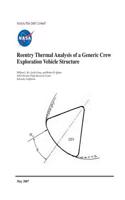
Reentry Thermal Analysis of a Generic Crew Exploration Vehicle Structure
Series:
Comparative studies were performed on the heat-shielding characteristics of honeycomb-core sandwich panels fabricated with different materials for possible use as wall panels for the proposed crew exploration vehicle. Graphite/epoxy sandwich panel was found to outperform aluminum sandwich panel under the same geometry due to superior heat-shielding qualities and lower material density. Also, repre
NaN
VOLUME
English
Paperback

Comparative studies were performed on the heat-shielding characteristics of honeycomb-core sandwich panels fabricated with different materials for possible use as wall panels for the proposed crew exploration vehicle. Graphite/epoxy sandwich panel was found to outperform aluminum sandwich panel under the same geometry due to superior heat-shielding qualities and lower material density. Also, representative reentry heat-transfer analysis was performed on the windward wall structures of a generic crew exploration vehicle. The Apollo low Earth orbit reentry trajectory was used to calculate the reentry heating rates. The generic crew exploration vehicle has a graphite/epoxy composite honeycomb sandwich exterior wall and an aluminum honeycomb sandwich interior wall, and is protected with the Apollo thermal protection system ablative material. In the thermal analysis computer program used, the TPS ablation effect was not yet included; however, the results from the nonablation heat-transfer analyses were used to develop a "virtual ablation" method to estimate the ablation heat loads and the thermal protection system recession thicknesses. Depending on the severity of the heating-rate time history, the virtual ablation period was found to last for 87 to 107 seconds and the ablation heat load was estimated to be in the range of 86 to 88 percent of the total heat load for the ablation time period. The thermal protection system recession thickness was estimated to be in the range of 0.08 to 0.11 inches. For the crew exploration vehicle zero-tilt and 18-degree-tilt stagnation points, thermal protection system thicknesses of h = {0.717, 0.733} inches were found to be adequate to keep the substructural composite sandwich temperature below the limit of 300 F. Ko, William L. and Gong, Leslie and Quinn, Robert D. Armstrong Flight Research Center
Price Comparison [India]
In This Series
Bestseller Manga
Trending NEWS




















